Exhibits’ Highlights
Santa Caterina Market | Image: Roland Halbe
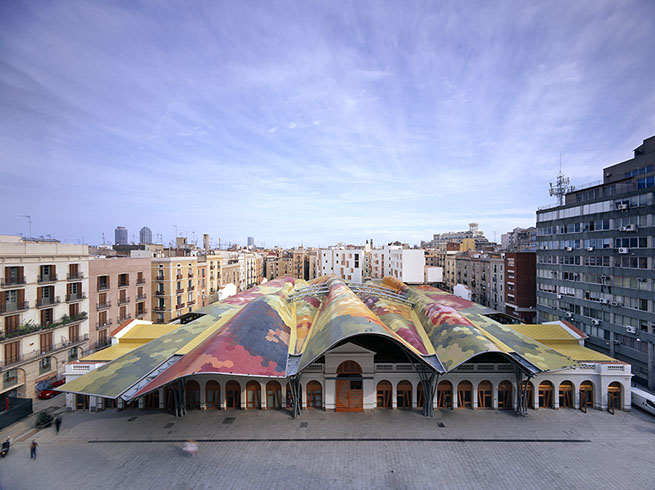
Park of Colours | Image: Duccio Malagamba
Clichy-Montfermeil Metro Station | Image: EMBT
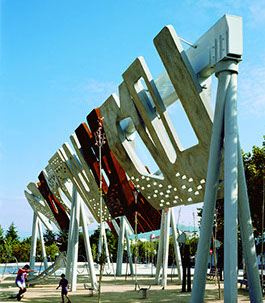
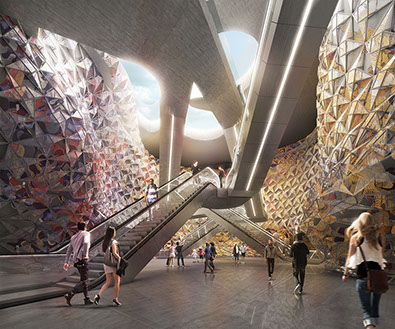
PERI and SANTA CATERINA MARKET
Barcelona, Spain (1997 – 2005)
“The Santa Caterina Market was a convent, a space where the sky opened up. Our project starts by criticising the actual planning and proposes a model that allows for adaption to the area’s complexity. Planning rules take into consideration more than just the street width and the building height. It will be the first scheme which allows for the development of the city’s complexity and which complies with the commitments undertaken in the project. We propose a model in which it is not so easy to distinguish between rehabilitation and new construction.”
PARK OF COLOURS
Mollet del Vallès, Spain (1992 – 2001)
“It is a place that could be defined as social topography. An opportunity to fix recent time in a given form has not yet arisen here. Almost nothing physical has left its mark here… or every building project has been cancelled. The building, which will emerge from this park, demands a topography and, hence it is what we must build first. This initial series of actions bears a resemblance to the operations in the consolidated city - marks on walls, bits of pavements etc. It is a game with time and a passive redefinition of the profiles and geometry of the zone that enables this place to occupy its centre.”
CLICHY-MONTFERMEIL METRO STATION
Paris, France (2014 – In design development / under construction)
“The Grand Paris is an ambitious project to modernise the existing transport network and create a new automatic metro – the Grand Paris Express for the Paris metropolitan area. New significant urban projects are planned to complete the works for this infrastructure. The station of Clichy – Montfermeil and the urban space above it present a special case because it has a symbolic public intervention with the suburban area which has been forgotten and abandoned for a long time. This neighborhood was the scene of the violent riots that occurred in October and November 2005 when cars and public buildings were burnt. A new station of the Grand Paris Express will be a symbol of change in these areas.”
Yeouido Riverside Park | Image: EMBT
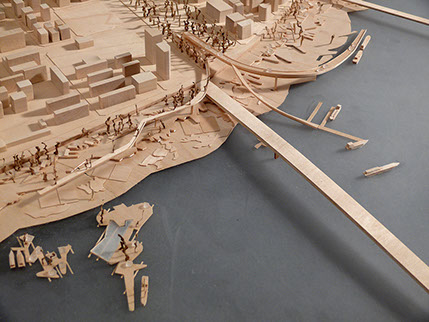
Hafencity Hamburg | Image: Roland Halbe
-crop-u564.jpg)
HAFENCITY HAMBURG
Hamburg, Germany (2002 – 2016)
“Our intervention is dynamic and flexible. It is a changing landscape on a human scale, moving partially with the floods, bringing people closer to the water and its moods. The new profile of the land has been studied with human needs in mind, so that people can feel relaxed here. The new urban planning engages with the public in a fluid movement from the new housing blocks down to the water, featuring for everyone’s enjoyment a new artificial landscape that is inhabited by natural elements: water and plants. People can find water and trees on every level of the public space.”
YEOUIDO RIVERSIDE PARK
Seoul, South Korea (2007 Competition)
“Yeouido Park is part of a series of Parks from the Han River redevelopment. The new Yeouido Park and the existing Saetgang Ecological Park should be seen as one continuous park surrounding the entire island. We propose sustainable features and vegetation to provide a seamless unity between the natural and the artificial.”
Osthafen Port | Image: EMBT
.jpg)
Bremerhaven Port | Image: EMBT
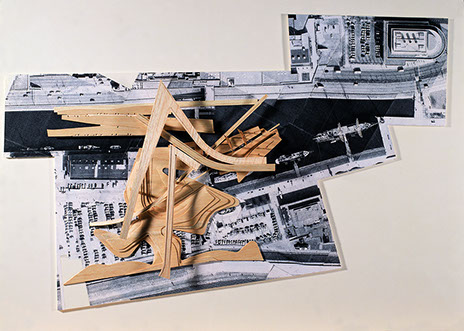
BREMERHAVEN PORT
Bremerhaven, Germany (1993 Competition)
“The physical reality of a port is an invisible reality tied to work and mercantile traffic, and in this port in particular to naval construction. Now that these activities have ceased, there remains a place occupied by incomprehensible fragments, a place that cannot be seen as a landscape in itself because the intensity of occupation that defined the port as an urban space has somehow vanished.”
OSTHAFEN PORT
Frankfurt, Germany (1992 Competition)
“This project is part of our urban planning series in Germany. Here an alternative use of the abandoned port area on the River Main was proposed to make it inhabitable. The sense of time is a very important aspect of the project. The question is, to what era does our project belong? We searched for the best moment in history to begin to plan in this place again.”
Spanish Pavilion for Expo 2010 | Image: Shen Zhonghai KDE

SPANISH PAVILION FOR EXPO 2010
Shanghai, China (2008 – 2010)
“The Spanish Pavilion for Expo 2010 Shanghai China sought to reflect upon the Spanish climate, as well as recover the extraordinary craft of wickerwork to bring it back to life and reinvent it as a new construction technique. This building sought to play with the incredible potential of wickerwork.
Furthermore, it sought to introduce wicker as a sustainable and viable material concept that would remain present throughout the building. Basketry techniques and handcrafts with natural fibres are global traditions shared by cultures of all ages. Even though they vary from region to region, they occur in similar ways whether in the East or the West. In this sense, the material choice for the pavilion attempted to bridge two cultures, the Spanish (visitors) and the Chinese (the host).”
Copagri Pavilion “Love IT” for Expo 2015 | Image: Marcela Grassi
-crop-u611.jpg)
COPAGRI PAVILION “LOVE IT” FOR EXPO Milano 2015
Milan, Italy (2014 – 2015)
“The design originated from the observation of Italian landscapes, both natural and man-made. The wooden dome ‘Love IT’, representing a message of sustainability is hosting several exhibitions to explore with visitors the topics proposed by Expo Milano 2015. At the end of the Expo – when all of the buildings will be removed – these domes can be easily dismantled, transported and reassembled in Italian landmarks with symbolic significance to host a variety of functions.”
Copyright 2015 Hong Kong Design Institute and Hong Kong Institute of Vocational Educatiion (Lee Wai Lee)